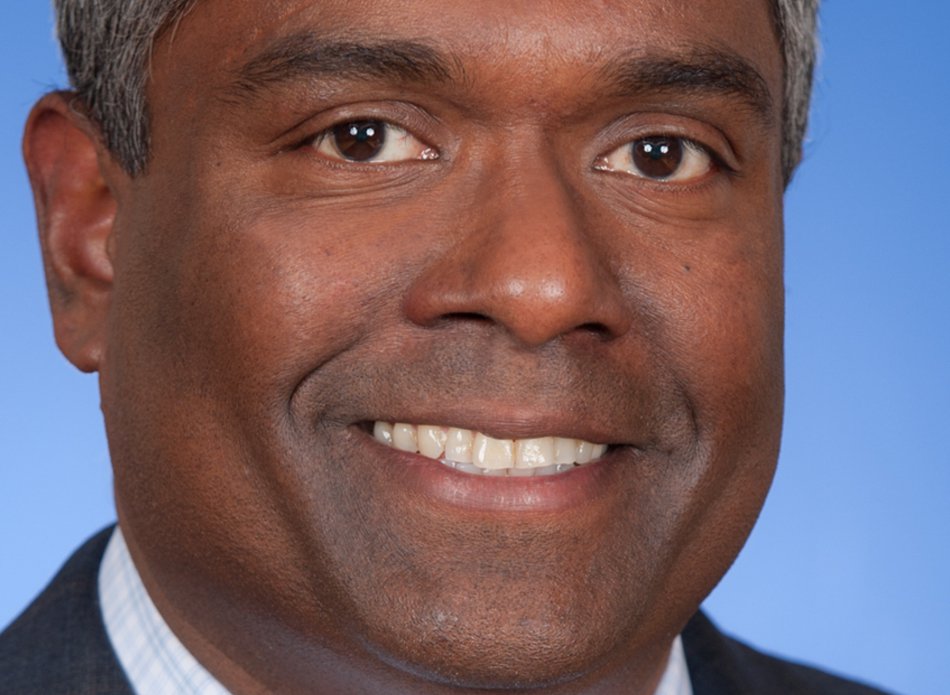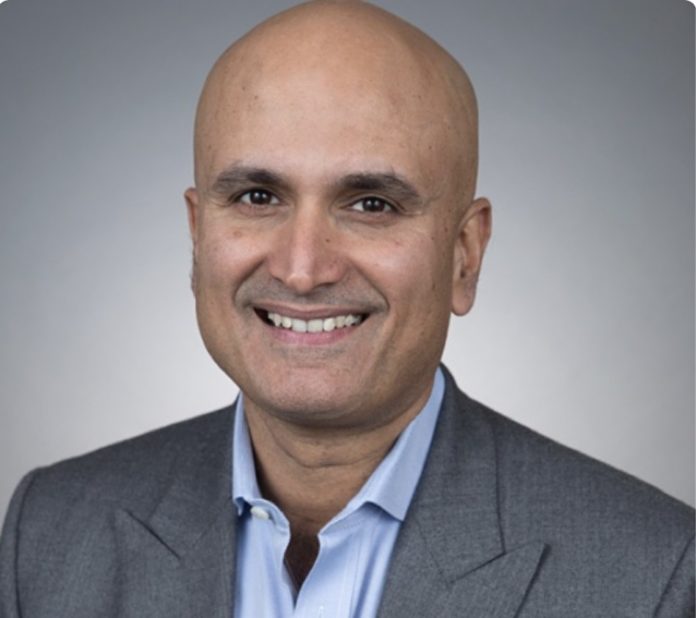Profile: SingleStore’s CEO Raj Verma is not a founder, or an early-stage startup guy, he comes from a sales background and worked for four companies who have IPO’d or sold to bigger fish. Now he’s in place to build an exit for SingleStore.

Verma’s family has an army background, distilling a work ethic and self-discipline in him, and after gaining his computer science degree: “I had the option of going to the States and pursuing a master’s in computer science, which I loved by the way, but I was too tired of being broke.”
So, with a computer science engineering degree, he stepped out of academia and started his working life at Wipro, hawking PC XTs, ATs and printers up the lifts and down the stairs of Delhi office blocks, knocking on doors and cold-calling prospects on each floor. He made money and “got promoted to sell Sun Microsystems” workstations before moving to Parametric Technology Corp. (PTC) to sell software.
He progressed to managing the north and east India region, moved around between Singapore, Australia and Hong Kong. He then joined Staffware to head up the Asia market. Tibco acquired Staffware in 2004 and he became strategic account manager for Asia.
Blocks & Files: What was the trigger for the move outside of Tibco?
Raj Verma: “I was doing well. Even doing software… I had kind of reached a level in my career. I could stay steady for the rest of my life. I was heading Asia. What else would you do living in Asia? … You aren’t going to get a global position [at a] US company when you are based in Hong Kong. That’s very, very rare.
And I said should I run with the big dogs, as they say in the US? Should you be a big fish in a small pond, or do you want to go and see how big a fish you can be in a big pond? So that was one trigger.”
And the second? Computerisation was changing the world and he was part of it: “The fact that life afforded me an opportunity to fundamentally change the world. It’s just something that I pinched myself thinking about, and even today. And what better place to go do it than in the Mecca [Silicon Valley].”
Blocks & Files: Did you go to a position or did you go and, as it were, start knocking on doors once you were there?
Raj Verma: I was with Tibco software. And I actually met my CEO and founder [Vivek Ranadivé] for the first time in Paris at that point. Somehow over dinner, we connected. … We walked back to the hotel in the lobby and he said, ‘You’re moving to the US. … You belong there, you’ve got to move.’ And literally two weeks later, I was there in the US running the business… my wife and kids joined me two months later, and we did not look back. It’s home now. So I did get a sort of a red carpet to the Valley.”
****

Unlike other Indian-born CEOs, Verma did not move to the US to complete his first or second-level degree and then join a consultancy (think George and Thomas Kurian at NetApp and GCP respectively) or join a HW/SW engineering company and then co-found a startup, like Mohit Aron and Dheeraj Pandey at Nutanix. Instead he climbed the corporate sales ladder and then took a transfer to the land of the free.
This background is a base for Verma’s thinking still today; there’s a persistence and discipline in his character – he says he’s been called a hard-ass – and a focus on what customers want and how to present products and services in that light. He’s also an enterprise person, not a startup founder, but he has ended up at a startup, an 11-year old late stage one.
Blocks & Files: “How do you find the Silicon Valley experience?”
Raj Verma: “The Valley is a very accommodating sort of place, you know, especially for us. We felt right at home very quickly.
“The only thing that matters is the content inside of you. And the dream and the drive that you have. It is very, very meritocracy driven. And it doesn’t matter whose son or uncle or aunt you know, or who you are. If you just have the grit, determination, and a bit of a dream about what you want to accomplish, you can make it happen. So it’s just a place that I found that I could spend the rest of my life.“
****
Verma climbed the Tibco corporate ladder, becoming Chief Operating Officer in 2016 and then leaving in 2017 to join Hortonworks as its President and COO. Some 7 months later he joined Apptus where he had multiple roles including Chief Strategy Officer, COO and Chief Revenue Officer. He then joined MemSQL as Co-CEO in 2020.
Blocks & Files: “What was the attraction of MemSQL?“
Raj Verma: “So I had about four exits in five years. Typically, we had sold them. Hortonworks got bought by Cloudera. Aptus we sold to Thoma Bravo. And so I’m sitting by the pool, I’ve got my two year old son on my lap, and I’m thinking I’m going to take a sabbatical, you know, finally take a sabbatical. I’d spoken to MemSQL in 2017 as I was exiting Hortonworks. I’d found the technology pretty attractive, engaging, but the scale was not of the size that I wanted.
“It was very small: $5 million, $7 million, $10 million – a very early stage startup and I wanted to probably join a later stage company at that point in my life. So as I was on the bench hanging by the pool with my two year old and I got a call from CEO Nikita [Shamgunov, MemSQL’s co-founder and CEO] and he said, “Hey Raj, would you like to come in?”
Blocks & Files: “Why co-CEO?“
Raj Verma: “The one thing that I found in at least two of the three companies that I was involved in, when the founder leaves the company part of the soul of the company departs with a founder. Tibco was never the same after Vivek [Ranadivé] left. I just wanted to make sure that our founder was involved for a duration of time that I could imbibe from him. I insisted on it. I wanted to make sure that Nikita was as involved as possible and I had the opportunity to learn from him the foundational principles.”
Blocks & Files: “It was a cultural continuity thing?“
Raj Verma: “Correct. And I just did not want it to be disrupted by the founder leaving.”
Blocks & Files: “MemSQL was an in memory SQL database, doing transaction work. Had it started thinking about combining transactional and analytical database technology at that point?”
Raj Verma: “So it was probably more analytical, less transaction. There was an element of transactions already there but the fact of further enhancing the transactional aspect of it wasn’t the strategy back then. It was essentially analytics, and whatever was a little bit of transaction to support the analytics.”
“I went and spoke to the customers, like Goldman Sachs. And the only question that I asked them was … what would you ideally want your data strategy to look like? And the answers that I got were; our data is too fragmented right now, there are silos of data that adds latency to the response that we provide our customers, we cannot be real time because there are too many silos, too much data movement, the databases aren’t fast enough, they aren’t flexible enough in a hybrid manner.”
“I think the name Singlestore was a result of those conversations. And yeah, it was just a name that spoke to our purpose.”
Blocks & Files: “When did you think of of combining analytical and transactional data?”
Raj Verma: “I remember the conversation when we decided to do that. That was 3rd August 2019. That vision, I remember that distinctly. We had a product off-site. And I’d been there for a month and I’d spent the majority of the month speaking to our customer base and prospect base, and understanding where we were with the evolution of our product. So we made two decisions. We will be hybrid and eventually cloud and cloud-only. And the company would combine analytical and transactional functions in a single database.
Blocks & Files: “Do you think that your customers would like you to move out to encompass even more types of data? Like streaming real time event data?“
Raj Verma: “100 percent. … In 2007 I remember the day I was outside my office, and Apple announced the iPhone. And we didn’t quite understand the enormity of that day, because that just changed everything, the combination of that and the social media environment. During this time you and I have spent together, from the start to the end, more data would have gotten generated in the world, than in the year entire year 2006. The enormity of data is just so huge you can’t even fathom it.”
[This has led to a multiplicity of different database types as online organisations try to store, analyse and manage their data.]
“What they did was they took the traditional database and they bandaided it with what I call swimlane databases – for JSON, for Mongo, for streaming. … To solve the complexity of modern data, what most organisations did is they created another complexity, which is the database sprawl. It’s very, very expensive. It causes a lot of latency, and it prevents people from operating in real time…. it’s just untenable.”
“When you have, let’s just call it 20 databases, to build an application, your point of failure is n squared minus one. So that’s 399 points of failure. You don’t want your application to have that. And also there are 20 different databases that data is loading to and from…”
“There should be a consolidation in the database space where you can have a wide variety of data sets and models and workloads within one framework, or one database. And that’s really the entire concept of a single store.
“The hope is that 3, 4, 5, 7 years from now, when we ask a large bank, what do they do with their data? Hopefully, the answer is only to put it a single store. ‘We just put our data in a single store, and run analytics software’.”
“Will there actually be one database? Probably not. But will there be eighty seven? Absolutely not. No, maybe three to five in an organisation… And we want to be one of the top three. Now, what they really want is a sort of repository of data for the majority of their workloads where they can query and the latency is extremely low, so the query speeds can be sub-second. And it’s hybrid. So you can use it wherever you want. And the user experience is good. And there are no walls between transactions and analytics.”
Blocks & Files: “Can you provide an example of how this would work?“
Raj Verma: “ I’ll give you an example of a tragic Indian cricket fan at Lords yesterday. Sadly enough, [it was a] great day except for the result. And I came out because India was losing. And there’s a madhouse as all the Indians were evacuating the ground and there are no taxis.
“And I took my phone. I ordered an Uber. Three minutes later, there was a beautiful black Mercedes that picked me and my wife up and we were at the hotel, beating London traffic. How did that happen?
“What happened behind the scene at Uber? So this driver woke up that morning, and he switched on his Uber. And the Uber app had the analytics to guide him to say there are 30,000 people congregating at the Lord’s Cricket Ground; the majority of whom would be drinking so they aren’t going to be driving, they would need public transportation. Hang around the vicinity of Lords as closer to 6:30 or 7:30pm. Three minutes later, my car was there. And then they calculated the fact that the demand and supply thing is in their favour. There’s a bit of traffic at that time in London. So an £18 ride cost me £42. Was I willing to pay. I did agree to pay. They monetized the data in real time.
“And Uber use us as a database.”
Blocks and Files: “How will you add extra types of data like streaming real time events?“
Raj Verma: “Adding events of any sort; that is not that much of a big deal to be honest. Once you’ve got that blueprint, that marriage of transactions and analytics in one platform, adding data types is not that difficult because it’s ultimately a JSON adapter, or whatever data type that you’re sucking into your database. The multi-model is what we call it.”
“We do IoT data and you can bring in that data. There is no reason why all of that doesn’t combine into a streaming data. So there’s absolutely no reason for us not to do that.”
****
SingleStore has 400 employees worldwide. With recent new funding the company is expected to grow to 700 employees and above. SingleStore also has 350 customers right now; some 50 percent of its bookings and revenue come from Fortune 500 organizations.
Blocks and Files: “Are you profitable?“
Raj Verma: “No, far from it. We don’t think it’s the right thing for us to be profitable right now. We are building towards long term profitability. This is a ginormous market – a $110 billion market. And I think right now we are optimising to maximise our rate of innovation. If I can innovate faster then I’m willing to borrow more capital to do so, because I think the sort of price at the end of it is enormous.
“We’re not running out of money. Can we use money to further accelerate our future potential, or get to a future potential earlier? Absolutely. Yes, you need money for it. … My business is to be able to plan out the next three to four years without saying that this strategy is dependent on me having to raise cash at the 18 month mark. So I’ve taken that barrier out, it’s better to have it in the bank now.”
“What you sacrifice is my valuation 18 months from now is going to be a lot higher than it is now. Right? Fine. So you have extra dilution. However, what this round provides me is a very clear path for the runway for the next four years. Milestones which we know we can fund, and be able to accelerate those milestones or that roadmap with the funds that we have. So we are going to actively use the money that we have raised to accelerate our rate of innovation and to grow our footprint globally. And to work more on having a more holistic ecosystem around us.”
Blocks and Files: “How do you look at the market? Will there be one winner with many losers?“
Raj Verma: “It’s $110 billion market. So let’s add all the modern data players, you know, Snowflake and Databricks and Mongo and Datastax. If you were to add all of them, I don’t think they will cross $7 billion in revenue.
There is 100 billion plus dollar data market that is stuck … with incumbent data players and that is going to be unleashed on us. And it’s not going to be on its incumbent platform. So let’s just say in this 100 billion dollar market, some $30 billion has a long tail that they don’t move for another 10 years. That leaves right off $70 billion. Let’s say two companies are going to be $10 billion plus in revenue. That leaves $50 billion. That means that 50 $1 billion companies could come out of the data space in the next three to five years. There’s going to be probably 25 $2 billion companies on an average. There is enough food for everyone.
“But If you don’t eat someone else’s lunch in the state of market, they’ll eat yours. There are some smart people running companies in our space. We are going to take the fight to the other camp aggressively and to many other camps. So we aren’t holding back. This is not our time to be shy. We’re going to take the fight to the other camp, we’re going to be aggressive, we’re going to poke the bear.”








